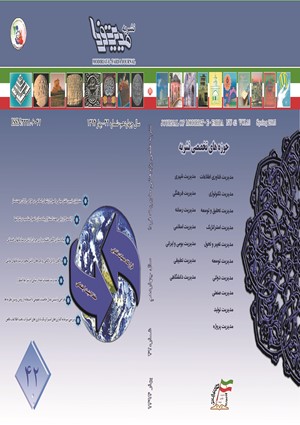ارائه مدل ارزیابی جهت استقرار و پیاده سازی تحول مناسب در شرکتها بر اساس تحلیل شبکه ای فازی
محورهای موضوعی : مدیریت صنعتی
کاظم نصیری کاشانی
1
,
محمود مدیری
2
,
غلامرضا هاشم زاده
3
![]()
1 - واحد علوم و تحقیقات دانشگاه آزاد اسلامی
2 -
3 - تهران
کلید واژه: تحول ناب تولید ناب سازمان ناب ارزیابی ناب فرآیند تحلیل شبکهای فازی دیمتل فازی ویکور فازی,
چکیده مقاله :
متدلوژی بسیار زیادی جهت ارزیابی تحول و دگردیسی ناب وجود دارد. اما تنها در تعداد کمی از این مطالعات، رابطه میان مولفههای تحول شرکتهای ناب، به صراحت و با تمرکز بر اولویتبندی و شناسایی وزن اهمیت نسبی هر عنصر از تحول ناب مورد بررسی قرارگرفتهاست. به همین دلیل ما تلاش میکنیم این روابط را در این مطالعه تعیین کمیت نماییم. در این راستا جهت بررسی ساختاریافته روابط میان عناصر، مدلی که نگرش جامع به فرآیند تحولناب فراهممیسازد، پیشنهادمیکنیم. این مقاله یک روش مدلسازی تحلیلی در تحول ناب سازمانی برای شناسایی وزن عوامل تحول ناب ارائه میکند که روابط بسیار کیفی میان عناصر تحول ناب را عملیاتی میسازد. در این پژوهش32 عامل موثر در تحول ناب شرکتها با عنوان "زیر زیرمعیار" شناسایی شد که در 8 دسته با عنوان زیرمعیار طبقهبندی گردید. در ادامه 8 زیر معیار در سطح بالایی در قالب 3 معیار با عنوان " توسعه سرمایه سازمانی"، "تطبیق سریع با بازار و کسب مزیت رقابتی" و "بهینه سازی شبکه تامین و توزیع " دستهبندی شد که هر سه معیار به عنوان معیارهای اصلی "ماکزیمم سازی ارزش تحویلی"، معرفی شدند و در نهایت ماکزیممسازی ارزش به عنوان اصلیترین هدف تحول ناب در شرکتها بر شمردهشد. جهت تعیین روابط و وزن اهمیت نسبی هر عنصر در مدل، از تکنیک دیمتلفازی و مدلسازی فرآیند تحلیل شبکهای فازی استفاده شد و سپس 25 راهکار شناسایی شده مرتبط با مدل مفهومی جهت اجرای تحول ناب، با توجه به اهداف سازمانی و ضرایب وزنی پارامترهای سطح اخر مدل مفهومی، از روش ویکور فازی در چارچوب پیشنهادی رتبه بندیگردید. مدل ارزیابی تحولناب سازمانی ارائه شده در پژوهش مدلی جامعی است که قابلیت بکارگیری در صنایع مختلف تولیدی را دارد. این مدل در صنایع قطعه سازی خودرو مورد بررسی قرارگرفت.
A lot of methodologies for evaluation of the lean transformation have been proposed in the literature, but just a few of them explicit relations among the components of the lean enterprise transformation, with focusing on the priority and identification of the relative weight of each element on the lean transformation have been considered. Therefore, we try to quantify those relations in this study. So, to structural investigate the relationships among the elements, a model is proposed that presents a novel comprehensive insight to the lean transformation process. This study proposed an analytic modeling approach in the lean enterprise transformation to identify the weights of the elements. The goal is to operationalize the highly qualitative relationships among the lean transformation components. In this paper 32 effective factors in lean enterprise transformation, identified as "sub sub criterion" were grouped into eight categories classified as "sub criterion". These eight sub criteria classified through 3 criteria in the higher level which are “organizational asset development”, “quick adaptation to markets and competitive superiority acquisition” and “supply and distribution network optimization These three criteria were proposed as the major criteria involved in "delivery value maximizing", and ultimately, the value maximizing recognized as the main target of the lean transformation in companies. Fuzzy DEMATEL technique and fuzzy analytic network process modeling are used to determine the relationships and the relative weights of each component and then with fuzzy VIKOR method, 25 identified solutions related to conceptual model were ranked for implementing the lean transformation which regard the organizational purposes and the weights of the end level parameters of the conceptual model in a proposal framework. The present evaluating lean enterprise transformation is a comprehensive model that can be applied to different production industries. This model also was investigated in automative parts industry.


